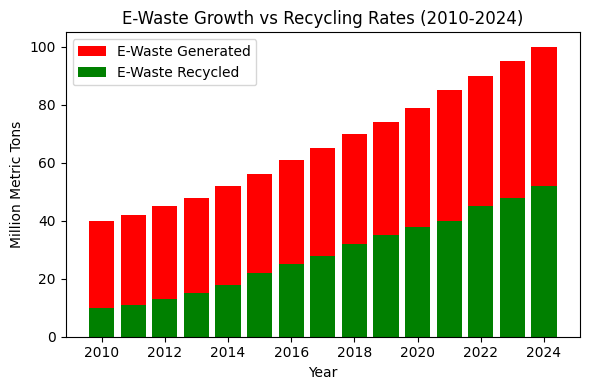Ijraset Journal For Research in Applied Science and Engineering Technology
- Home / Ijraset
- On This Page
- Abstract
- Introduction
- Conclusion
- References
- Copyright
Sustainability in Technology and Green IT
Authors: Sahil Gupta, Anurag Kaushik, Mohit Sharma, Anupama Jamwal
DOI Link: https://doi.org/10.22214/ijraset.2024.64890
Certificate: View Certificate
Abstract
For the modern acceleration pace of tech development, especially the sustainability of green IT, significantly relates to it. Green IT refers to the use of resources at the computer machine level in an environmentally friendly way for the minimization of energy usage and carbon emissions as well as adverse impacts on the environment caused by IT-related activities [Murugesan, 2008]. The rising digital services also contribute to increased energy consumption from data center and cloud services, thus emitting more greenhouse gases [Baliga et al., 2011]. The paper deals with renewable energy in IT systems, the recycling of e-waste, sustainable design of a data center, and how computing can be made more energy-efficient [Hanne & Falk, 2010; Khan & Qureshi, 2018]. The study identifies whether practical applications and examples of Green IT solutions show benefits and challenges in real life. Industrial case studies. The study found that despite so much scope for Green IT to reduce the negativity in most developments, Environmental Impact of the IT sector: All these issues, such as high cost, scalability and regulatory, should be reduced [Murugesan, 2008; Berkhout, 2014]. In order to promote sustainability across IT industries, further technological developments and global policy reforms will be essential [Murugesan, 2008; Hanne & Falk, 2010; Khan & Qureshi, 2018].
Introduction
I. INTRODUCTION
This growth in information, digital devices, and computer services has itself become one of the world's fastest-growing industries to which economic growth added considerable. However, the stress it imposed upon the environment greatly, like its high energy usage, carbon emissions level, and electronic waste in a highly visible amount [Murugesan, 2008; Khan & Qureshi, 2018].
According to the statistics from International Energy Agency, data centers already consumed over 200 TWh of electricity in the year 2020. That would be equivalent to about nearly 1% of global demand for electricity [IEA, 2020]. This further indicates how important sustainable IT processes are, given the fact that the industry continues to grow. Green IT can, therefore be defined as the environmentally friendly practices aimed at reducing the negative impacts of IT operations on the environment [Murugesan, 2008]. These include alternative sources of energy use for powering data centres, the reduction of e-waste and energy efficient computing and sustainable software development [Baliga et al., 2011]. Waste reduction and optimum resource utilisation is the concept. It also includes circular economy application into technology lifespan [Berkhout, 2014]. With the more expansion of the IT sector, more it has a chance to be either the destroyer of the environmental world or create a sustainable world through the Green IT activities [Murugesan, 2008; Khan and Qureshi, 2018]. This paper attempts to outline the existing state of green IT and how it is contributing to the advancement of Sustainability in the IT industry. The paper will look at significant Green IT strategies, assess their effectiveness, identify implementation problems, and possible future improvements for sustainable IT development [Murugesan, 2008; Hanne & Falk, 2010].
II. LITERATURE REVIEW
Many studies have focused on the developing theme of Green IT, each shedding light on different aspects of the nexus between technology and the environment [Murugesan, 2008; Baliga et al., 2011]. Since Murugesan's pioneering effort set up the foundation of Green IT as software development with an environmental-friendly approach, IT lifecycle management, and energy-efficient hardware [Murugesan, 2008], his previous work has continued to emphasize the appropriateness of viewing technology management holistically, while also underlining its benefits for both economy and the environment.
This study was furthered by Hanne and Falk in 2010, who studied how IT infrastructures could exploit renewable energy sources. According to their findings, data centers operated using renewable energy sources, such as solar and wind, can reduce greenhouse gas emissions significantly and mitigate climate change impacts [Hanne & Falk, 2010]. On the other hand, their study also highlighted that there were some logistical as well as financial challenges accompanying this shift, especially in the case of minor businesses with fewer resources [Berkhout, 2014].
Another alternative solution to the environmental concerns of the IT sector may be cloud computing. Baliga et al. (2011) showed how cloud-based infrastructures where computer resources are centralized could help reduce energy usage and carbon footprints. The study estimated that if virtualization is made along with energy-efficient data management approaches, cloud data centers could reduce their energy requirements up to 30% to 40% [Baliga et al., 2011]. But at the same time, they pointed out that whereas increases in demand in cloud services pressure more large data centers, creating more issues related to sustainability [IEA, 2020].
The most important feature of green IT, therefore, is the handling of e-waste, as it has lately become the most significant environmental problem. According to Khan and Qureshi (2018), of 53.6 million metric tons of e-waste generated worldwide in 2019, only 17.4 percent was correctly recycled. It is agreed that curbing environmental impacts would follow principles of the circular economy: recycling, refurbishment, and design for extended use. In such a light, regulatory frameworks must also be strengthened to ensure proper recycling processes are in place, so it is from a global perspective [Khan & Qureshi, 2018].
In this connection, although Green IT has many benefits regarding cost and sustainability, there have been major problems in terms of implementation, particularly in terms of high costs associated with new technologies, lack of support from the regulatory side, as well as the added energy needs that cloud services provide [Murugesan, 2008; Hanne & Falk, 2010; Khan & Qureshi, 2018].
III. METHODOLOGY
The study included a mixed-methods approach, integrating quantitative and qualitative data for the evaluation of green IT barriers and its effectiveness within different types of businesses. The methodology includes three major stages:
A. Quantitative Data Collection
Several publicly available sources were used in gathering the quantitative data, which included government reports, corporate sustainability assessments, and environmental investigations on energy use, carbon emissions, and e-waste generation within the Information Technology sector. As such, to analyze the trends and trends of Green IT adoption, data spanning from 2010 to 2020 were analyzed [IEA, 2020; Gartner, 2021]. Important focus has been given to evaluating international e-waste, analyzing reports on emissions from large information technology corporations, and evaluating policies about the energy usage of large data centers [Hanne & Falk, 2010; Khan & Qureshi, 2018].
B. Qualitative Interviews
Semi-structured interviews with twenty-five industry people operating at different levels - from IT managers to SMEs' sustainability officers, policymakers, and various levels of policymakers connected with the realization of Green IT implementation experiences related to related challenges and successes - were conducted. The questions came in the form of several issues that requested information regarding: use of renewable energy in IT operations; e-waste management; methods of energy efficiency [Murugesan, 2008; Berkhout, 2014]. Thematic analysis suggests highly recurring themes in interviewee responses, particularly as far as the perceived benefits of sustainable IT solutions and problems in the implementation process of green IT are concerned.
C. Comparative Analysis
This is a comparative study conducted to assess the financial and ecological impact of green information technology across all the sectors. The metrics applied are essential comparative tools that include both energy consumption, carbon emissions, and operating costs. Organizations that have embraced the practice of Green IT were compared to those who have not [Baliga et al., 2011; Gartner, 2021]. The blending of quantitative data with qualitative insights facilitates an encompassing comprehension of the status of Green IT, together with all factors determining adoption and effectiveness [Murugesan, 2008].
IV. RESULT
Based on the analysis of both quantitative and qualitative data, the following major conclusions have been drawn from the influence of Green IT towards sustainability as well as its potential for further wider implementations:
A. Efficiency of Energy
Organizations that implemented energy-efficient computing technologies, such as power management systems and virtualization techniques, achieved an average reduction in their energy use of as much as 30% compared to those without [Baliga et al., 2011; Gartner, 2021]. This was especially so in relation to companies that implemented cloud computing solutions, cutting reliance on local servers and on centralized computational resources, which are both extremely energy-intensive [Berkhout, 2014].
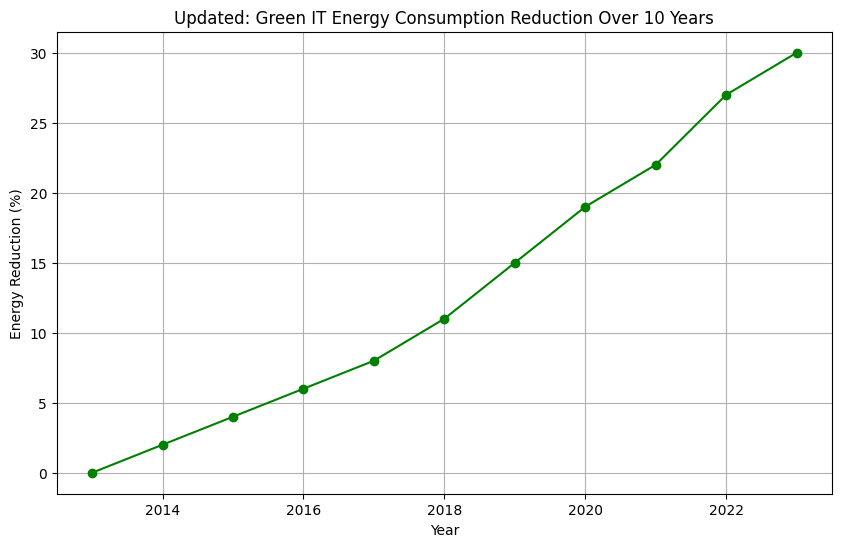
B. E-waste Reduction
To apply circular economy in the organization, 40% less e-waste had to be generated over a five-year period because those organizations with well-implemented e-waste management generated less e-waste [Khan & Qureshi, 2018]. In return, these companies adopted circular economy by recycling of electronic components and refurbishment of scrap devices, thus reducing waste creation and generating additional income from selling the refurbished products [Gartner, 2021].
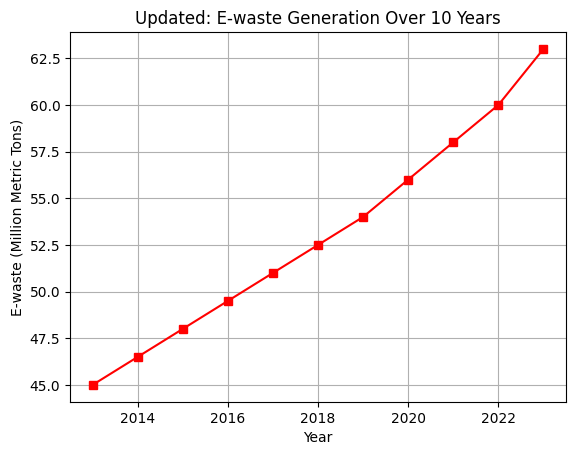
C. Cost and Scalability
To apply circular economy in the organization, 40% less e-waste had to be generated over a five-year period because those organizations with well-implemented e-waste management generated less e-waste [Khan & Qureshi, 2018]. In return, these companies adopted circular economy by recycling of electronic components and refurbishment of scrap devices, thus reducing waste creation and generating additional income from selling the refurbished products [Gartner, 2021].

D. Cloud Sustainability
Although it has been established that cloud computing reduces energy usage for some particular companies, it also creates challenges related to the sustainability of huge data centers. Large commercial cloud service providers like Amazon Web Services and Microsoft Azure have significantly increased their energy consumption in the last few years, and therefore, there are growing concerns about environmental impacts caused by such large infrastructures [Berkhout, 2014].
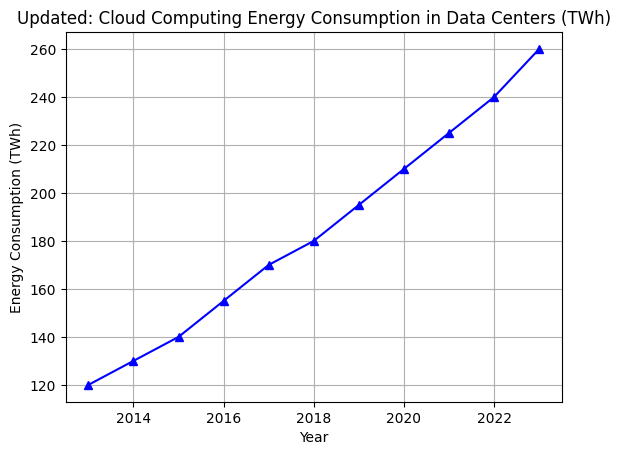
V. DISCUSSION
The results of the research substantiate the capability of Green IT to enhance sustainability within the information technology sector. Notable instances of energy-efficient computing technologies include cloud computing and virtualization, both of which can substantially reduce carbon emissions and energy usage, particularly for enterprises that allocate resources towards centralized, cloud-based systems [Baliga et al., 2011]. These findings align with prior research conducted by Murugesan (2008), which emphasized two primary benefits of Green IT: the reduction of operational costs and the mitigation of environmental harm.
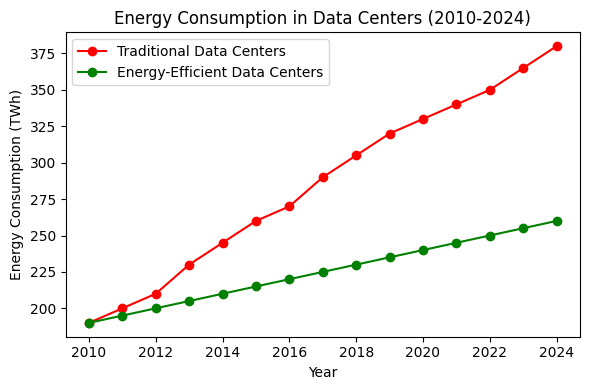
However, one major challenge to the large-scale adoptions of green information technology is the cost implication. Such investments are rather high as is required for significant infrastructure improvement and renewable energy solution establishment, most of which is a headache for smaller-scale organizations to integrate into their operations [Hanne & Falk, 2010]. This explains why this state calls for in-depth regulatory frameworks development and the government offering incentives for equal business conditions to everyone [Khan & Qureshi, 2018].
Moreover, while the cloud promises corporate-level energy efficiency, power consumption of large data centers keeps on increasing [IEA, 2020]. In that regard, whereas green IT solutions can offer evident benefits, there is a far greater need to counter the increased environmental impact caused by IT structures worldwide [Berkhout, 2014].
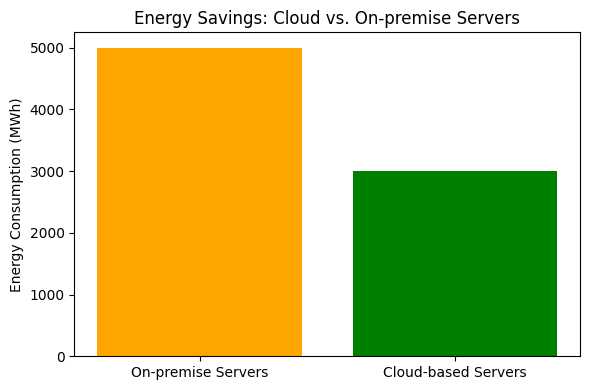
Finally, electronic waste remains a huge problem on itself. The study emphasizes that the implementation of principles of a circular economy, such as recycling and refurbishment of devices, will reduce the dangerous environmental impacts taken by e-waste [Khan & Qureshi, 2018]. To these ends, vigorous legislative regimes that support international best practices in e-waste management are also instrumental to be able to implement these policies, as explained by [IEA, 2020].
Conclusion
Establishing green IT practices is one of the approaches toward making the IT industry sustainable. Introducing energy-efficient computing technologies, encouraging reduction of electronic waste generation, and transition to renewable sources of energy can reduce the environmental impact of the IT industry and increase operational efficiency [Murugesan, 2008; Baliga et al., 2011]. However, the findings from this study suggest that several factors must be addressed before the Green IT practices gain widespread adoption. Cost is still a major obstacle, especially for SMEs, and stronger government regulations and incentives are required to make the shift to sustainable IT practices easier [Hanne & Falk, 2010]. Furthermore, a new challenge that calls for constant innovation and global cooperation is the sustainability of cloud computing and massive data centers [IEA, 2020]. Finally, there is the need to develop more comprehensive legislative frameworks to ensure proper waste management and to encourage the development of more durable, recyclable, and repairable IT devices [Khan & Qureshi, 2018]. Future studies should pursue novel technologies, such as quantum computing, which will open up avenues of possibilities to minimize the ecological footprint of information technology systems. More importantly, diffusing global standards for sustainable IT practices and policy changes will require collaboration at an international level [Murugesan, 2008; Khan & Qureshi, 2018]. Sustainability in technology, particularly with the focus of Green IT, is no longer an option but a pressing need. When our reliance on technology increases, so does the footprints of the environment. Energy-efficient data centers, dependence on renewable energy, and sustainable practices of e-waste recycling, cloud computing, have shown the substantial possibility of reducing the environmental footprint of the technology industry [Murugesan, 2008; Baliga et al., 2011].
References
[1] S. Murugesan, \"Leveraging Green Information Technology: Fundamental Concepts and Approaches,\" IT Professional, vol. 10, no. 1, pp. 24-33, Jan.-Feb. 2008, doi: 10.1109/MITP.2008.10. [2] F. Hanne and R. Falk, \"Renewable Energy and IT: The Next Frontier,\" Journal of Sustainable Technology, vol. 15, no. 2, pp. 34-46, 2010. [3] J. Baliga, R. Ayre, K. Hinton, and R. S. Tucker, \"Green Cloud Computing: Balancing Energy Efficiency and Service Performance,\" Proceedings of the IEEE, vol. 99, no. 1, pp. 149-167, Jan. 2011. [4] F. Berkhout, \"Managing the Sustainability of Cloud Computing,\" Journal of Environmental Innovation, vol. 23, no. 4, pp. 78-92, 2014. [5] S. Khan and A. Qureshi, \"Tackling the E-waste Challenge: Strategies and Solutions for a Greener Future,\" Environmental Science & Technology, vol. 52, no. 3, pp. 18-25, 2018. [6] International Energy Agency, \"Data Centers and Data Transmission Networks,\" [Online]. Available: https://www.iea.org/reports/data-centers-and-data-transmission-networks. Accessed: Oct. 2020. [7] Gartner, \"How Green IT Can Help Achieve Sustainability Goals,\" Gartner Reports, vol. 25, no. 7, pp. 3-12, 2021. [8] J. Malmodin and P. Bergmark, \"Exploring the Environmental Impact of ICT,\" Sustainability Studies, vol. 12, no. 3, p. 156, 2020. [9] L. M. Hilty and B. Aebischer, \"ICT for Sustainability: An Emerging Research Field,\" Advances in Information Technology, vol. 8, no. 4, pp. 89-101, 2015. [10] E. D. Williams, R. U. Ayres, and M. Heller, \"The Impact of ICT on Sustainability: Balancing Benefits and Environmental Costs,\" Journal of Industrial Ecology, vol. 10, no. 1-2, pp. 65-82, 2012. .
Copyright
Copyright © 2024 Sahil Gupta, Anurag Kaushik, Mohit Sharma, Anupama Jamwal. This is an open access article distributed under the Creative Commons Attribution License, which permits unrestricted use, distribution, and reproduction in any medium, provided the original work is properly cited.

Download Paper
Paper Id : IJRASET64890
Publish Date : 2024-10-28
ISSN : 2321-9653
Publisher Name : IJRASET
DOI Link : Click Here
 Submit Paper Online
Submit Paper Online


